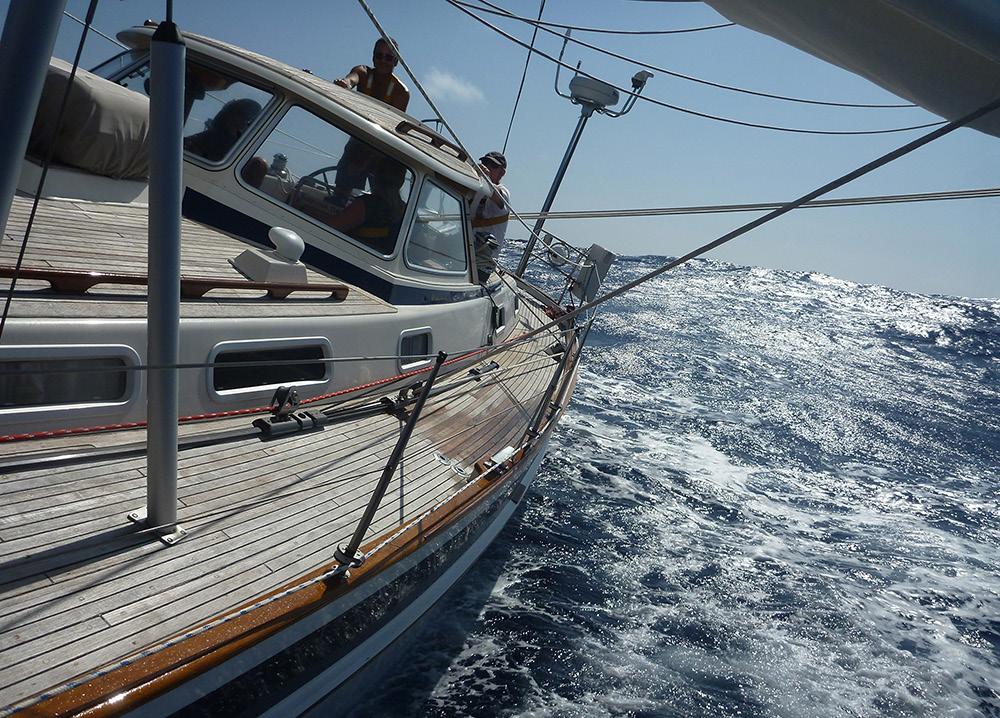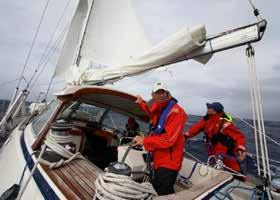
10 minute read
Bluewater Adventure
Cruising Boat Construction
A veteran voyager and expedition leader explains the essential elements of blue water cruising boats By John Neal
Advertisement
HULLS
Fiberglass is the second least maintenance-intensive material (following unpainted aluminum) for cruising boats, but construction quality varies greatly from one builder to the next. The majority of fiberglass boats were never designed or built for extended ocean sailing and may eventually start falling apart if pressed into this type of service. The other extreme are designs that are so heavily built and overweight and do not have the sailing performance that makes for fast, comfortable and enjoyable passages.
SELECTING AND PURCASHING AN OCEAN CRUISING SAILBOAT



Pearson Vanguards, Tritons and Alberg 35’s are examples of very well built, reasonably priced earliest fiberglass boats. After 50 years, many of these boats are still going strong, although their short waterlines and modest volume make them less attractive than more modern designs.
Hull thickness doesn’t necessarily translate into strength. A thick hull with a high resin to glass ratio may actually be more brittle than a thinner hull where the resin has been carefully squeegeed out.
Some builders have a history of serious osmotic blister problems, sometimes the result of lack of temperature and humidity control during lay-up. In some cases, blistering may be serious enough to require a bottom peel, the removal and replacement of part of the hull laminate. This can be very expensive and time consuming and may occur again later. A knowledgeable surveyor will be an excellent resource and frequently will recommend looking for a different boat if the blisters are deep and extensive. oxidized aluminum hulls attractive, they are sturdy and practical. Aluminum suffers from electrolysis more severely than steel; if you own an aluminum boat, you’ll need to be very careful when installing gear and when moored in electrically “hot” marinas. Quality aluminum builders include Allures, Garcia and Boreal in France and Kanter in Ontario, Canada.
If the hull is balsa-cored and the core material becomes saturated because of improperly installed thru-hulls, or if the boat has “gone on the beach” you may want to look at a different boat because of the cost of repairs and potential for future problems. This is frequently an issue with ex-charter catamarans. Steel is an excellent boatbuilding material, frequently the choice of sailors who have done extensive offshore cruising. The impact resistance and total watertightness of the hull, deck and fittings is an advantage. With sandblasting and new epoxy coatings, steel takes
Foam-coring provides excellent insulation above the waterline but there can be problems with water absorption if coring is used below the waterline.
Read Surveying Yachts and Small Craft by Paul Stevens, Adlard Coles Nautical, 2010 or Surveying Fiberglass Sailboats by Henry C. Mustin, International Marine, 1994 for a clear and concise view of hull and deck design, structure, and condition.
Aluminum boats are generally lighter and faster than steel boats, have less impact resistance and may be slightly more difficult to have repaired in remote shipyards. Painted aluminum boats often tend to develop paint blisters after five years, requiring an expensive paint job if you want a fair and shiny hull. There are hundreds of unpainted French aluminum boats cruising the world, and although you may not find their concrete-colored less time to maintain than it used to, although it still requires more time and cost to maintain than an unpainted aluminum or fiberglass boat. Some of the steel boats on the North American and Australian markets are ownerbuilt hard-chine designs. Although strong and stiff, they are not particularly fast or attractive to many people’s tastes. A poorly-built steel boat will have places on the inside of the hull that will trap water and rust through from the inside out. Access to every part of the interior of the hull makes checking for corrosion and painting much easier.
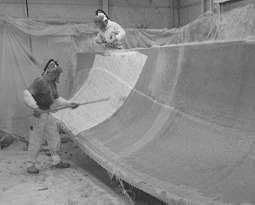
Some attractive, modern steel cruising boats are the Waterline Yachts built in Sidney, BC (an excellent yard), Kanter Yachts, Brewerdesigned Goderich Yachts built in Ontario, and the Amazon 37 and 44 which were built in Vancouver, BC. Dutch and German-built steel boats are frequently of very high quality. Wood boats often offer a lower purchase price, although the cost and time involved in keeping them in good shape is more than with other materials. If you have a limited budget, and don’t mind the additional work, a well-built ration (WEST System) technique are lighter, stronger and often faster than traditionally built boats and have a better chance of being insurable for ocean cruising. The best areas to find modern cold-molded boats are in the New Zealand and NW and NE U.S.
wooden boat could be a reasonable choice. It may be difficult to find long-distance offshore insurance for traditionally built wooden cruising boats.
Perhaps because there are so many potential sources of problems on wooden boats in the tropics we see fewer of them long distance cruising each year. There is the special warmth and appeal of wood that some people find irresistible, whether or not it takes more care and maintenance. Ferrocement is the only material that has no advantages other than inexpensive construction materials. It is the most labor-intensive material to build with, is difficult to finance, insure or repair, and has the lowest impact resistance of any material. Having said this, I have met two cement cruising boats that have completed two and three circumnavigations respectively.
TANKS
Stainless steel is the best tank material for water and fuel tanks. Aluminum tanks are less expensive and lighter but frequently develop pin-hole leaks after 15 years. Chlorine, present in most municipal drinking water dissolves aluminum. Chlorine can be filtered out when filling tanks, but without a small amount of chlorine in the tropics, bacteria and algae can foul drinking water. Aluminum fuel tanks are also subject to corrosion and leaks. Frequently builders install tanks, build the interior over them, and then install the house and decks. Removal and replacement of the tanks can be shockingly expensive. In December 2014, Practical Sailor, Patrick Childress relates how he cured leaking aluminum water tanks on his Valiant 40 using Amerlock 2. He also recommended more acceptable “food grade” two-part tank coatings designed specifically for potable water systems including: Rust-Oleum W9200, Hempel Hempadure 3556 and Sherwin Williams Tank Clad HS Epoxy.
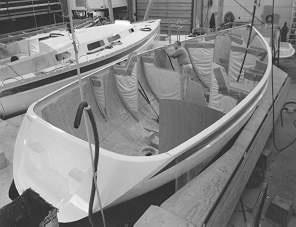
Steel fuel tanks, commonly called “black iron” and found on many Taiwan boats nearly always needs to be replaced and quotes to replace with stainless often run over $12,000 per tank if the interior woodwork needs to be removed before the tank. of the reasons for the large price difference between high-volume mass-produced French and German yards and higher quality, lower volume builders.
BULKHEADS
On a fiberglass boat, bulkheads need to be securely glassed to the hull and deck on both sides with multiple layers of tape. High production builders skip this labor-intensive step, gluing bulkheads in instead. Once these boats have had a hard grounding or made several ocean passages, bulkheads and interior wooden cabinetry frequently come unbonded from the hull and deck, allowing the hull to flex more than it should. The repair is complicated, messy and expensive, involving grinding and fiberglassing in some difficult to reach areas. Internal stiffening systems (grid floor systems, and/ or full-length and transverse glass over foam (not wooden stringers) contribute greatly to the stiffness and rigidity of a boat. If the interior woodwork is just glued or lightly attached to a hull liner pan or to the hull, it’s not uncommon to discover it breaking loose after a few thousand miles of ocean sailing. Access to hull and deck areas is generally restricted when fiberglass liners and pans are used in construction, making equipment installation and leak stopping difficult. From a manufacturing standpoint, hull liners are substantially less expensive than “stick-built” interiors, but you won’t find them on top-end ocean cruising designs. This is one
DECKS
The deck surface must provide adequate nonskid without being overly abrasive on bare knees. If you plan on living aboard or cruising in non-tropical areas, insulated decks will reduce condensation and moisture.
Teak decks look great at the boat show, but on
older boats thin or improperly laid decks will present additional leak potential and maintenance and the cost of removal or replacement is often a deal breaker.
In the ‘70’s and ‘80’s, many Taiwan yards installed teak decking over plywood or random bits of wood. Serious water absorption problems started occurring once these boats were 10-to15 years old. If the plywood core material is not marine grade (it commonly was not) or if insufficient bedding compound was used, water follows the screw threads to the core

material which becomes saturated and rots. This is a deal breaker. Check with any marine surveyor to verify this and avoid these boats. I would recommend having a surveyor look very carefully at any boat older than six years with balsa-cored decks. Unless the core has been eliminated in favor of a solid laminate where stanchion bases, genoa tracks, cleats and other deck fittings are placed, water will penetrate the balsa sooner or later, and repairs may be extensive and expensive.
If the boat has foam-cored decks, the marine surveyor will check all horizontal surfaces elasticity. Due to the working of the boat and the different climatic conditions the toerail and hull expand, contract and flex at different rates eventually weakening the bond, allowing water to follow the bolt or screw threads down, and drip on the inside of your lockers.
Two Methods of Solving Cap Rail Leaks
Remove the teak cap rail or aluminum extruded toerail and clean and re-bed each bolt. Radius the inside of the joint with epoxy and microballoons and then lay several layers of fiberglass tape over the inside of the joint, totally sealing it and strengthening the area at the same time.
A more trouble-free hull to deck joint utilizes substantial fiberglass bonding on the interior of the joint, eliminating mechanical fasteners and leaks.
carefully for voids or delaminating by tapping with a small hammer.
MAST STEPS
Deck stepped masts work well if proper structural members transmit the load to the keel. They have no leaks or corrosion and are simpler to pull for inspection. With keel stepped masts, inspect for leaks and corrosion at the base of the mast. Check the mast step of any mast for settling or deformation. Check any mast for trueness.
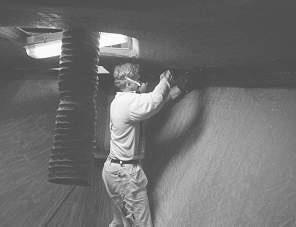
HULL TO DECK JOINT
There are several methods of attaching the hull and deck of fiberglass boats. The most common method utilizes bolts or screws protruding through on the inside of the hull to the deck joint. This mechanical clamp joint is relying on the bond of a sealant adhesive (3M 5200 is often used) to stop leaks. After 10 to 12 years and several thousand miles of ocean sailing the sealant/adhesive loses some of its
CHAINPLATES
The loading from chainplates must be evenly transmitted to bulkheads and structural members below deck to avoid lifting or distorting the deck. Separate chainplates for forward, upper and aft shrouds provides more stability for the mast and reduces the chance of deck loading distortion.
sive installation for the builder and a tighter sheeting angle for the headsail, but frequently present a chafe problem when easing the main out for deep downwind sailing.
External chainplates (fastened to the outside of the hull) look salty but have a much higher leak potential and restrict jib sheeting angles. Chainplates must be easily removable as crevice corrosion, particularly in warm climates can be a serious issue. reputable company like Edson, Jeffa or Lewmar/Whitlock where you’re assured of quality components and that you’ll always be able to source spare parts if needed. Many older Taiwanese-built steering systems suffer from poor initial design, inferior bronze castings and rudders that aren’t able to hold up to the stresses of ocean sailing. This is less of a problem on higher quality Taiwan boats like Norseman, Taswell, Mason and Little Harbor.
STEERING SYSTEMS
Some sailors prefer tillers on boats under 35 feet as there are fewer moving parts and installing most windvane steering systems is less complicated than with wheel steering.
If the boat you’re considering has wheel steering, hopefully the system was built by a
EMERGENCY STEERING
Emergency steering means, in the best case, that you can steer the boat plus or minus 30 degrees. A very workable alternative if the rudder is undamaged but steering is not working is having an autopilot ram connected to a separate tiller arm bolted directly to the rudder shaft. BWS
